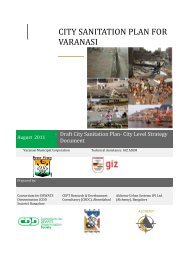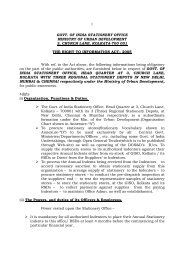CITY SANITATION PLAN - Ministry of Urban Development
CITY SANITATION PLAN - Ministry of Urban Development
CITY SANITATION PLAN - Ministry of Urban Development
Create successful ePaper yourself
Turn your PDF publications into a flip-book with our unique Google optimized e-Paper software.
<strong>CITY</strong> <strong>SANITATION</strong> <strong>PLAN</strong> BAREILLY<br />
sludge should be removed annually using a vacuum truck to ensure proper functioning <strong>of</strong> the Septic<br />
Tank.<br />
Pros & Cons:<br />
Can be built and repaired with locally available materials<br />
Long service life<br />
No real problems with flies or odours if used correctly<br />
Low capital costs, moderate operating costs depending on water and emptying<br />
Small land area required<br />
No electrical energy required<br />
Low reduction in pathogens, solids and organics<br />
Effluent and sludge require secondary treatment and/or appropriate discharge<br />
Requires constant source <strong>of</strong> water<br />
Reference: Mara, DD (1996), Low-Cost <strong>Urban</strong> Sanitation. Wiley, Chichester, UK (Sizing, volume and<br />
emptying calculations and example design solutions, Chapter 6)<br />
Pour Flush toilet with double leach pit<br />
Application Level- Household<br />
A Pour Flush Toilet is like a regular Flush Toilet except that instead <strong>of</strong> the water coming from the<br />
cistern above, it is poured in by the user. When the water supply is not continuous, any cistern Flush<br />
Toilet can become a Pour Flush Toilet. Just like a traditional Flush Toilet, there is a water seal that<br />
prevents odours and flies from coming back up the pipe. Water is poured into the bowl to flush the<br />
toilet <strong>of</strong> excreta; approximately 2 to 3L is usually sufficient. The quantity <strong>of</strong> water and the force <strong>of</strong><br />
the water must be sufficient to move the excreta up and over the curved water seal. Both pedestals<br />
and squatting pans can be used in the pour flush mode. Due to demand, local manufacturers have<br />
become increasingly efficient at mass-producing affordable, Pour Flush Toilets and pans. The S-shape<br />
<strong>of</strong> the water seal determines how much water is needed for flushing. To reduce water requirements,<br />
it is advisable to collect toilet paper or other dry cleansing materials separately. The waterseal at the<br />
bottom <strong>of</strong> the Pour Flush Toilet or pan should have a slope <strong>of</strong> 25 to 30°. Water seals should be made<br />
out <strong>of</strong> plastic or ceramic to prevent clogs and to make cleaning easier. The optimal depth <strong>of</strong> the<br />
water seal is approximately 2cm to minimize the water required to flush the excreta. The trap should<br />
be approximately 7cm in diameter.<br />
ADMINISTRATIVE STAFF COLLEGE OF INDIA, HYDERABAD Page 149
















